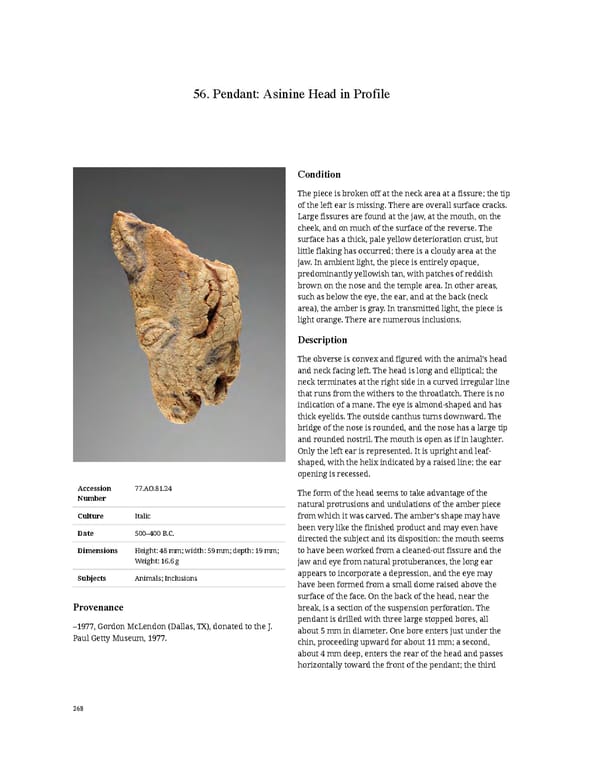56. Pendant: Asinine Head in Profile Condition The piece is broken off at the neck area at a fissure; the tip of the left ear is missing. There are overall surface cracks. Large fissures are found at the jaw, at the mouth, on the cheek, and on much of the surface of the reverse. The surface has a thick, pale yellow deterioration crust, but little flaking has occurred; there is a cloudy area at the jaw. In ambient light, the piece is entirely opaque, predominantly yellowish tan, with patches of reddish brown on the nose and the temple area. In other areas, such as below the eye, the ear, and at the back (neck area), the amber is gray. In transmitted light, the piece is light orange. There are numerous inclusions. Description The obverse is convex and figured with the animal’s head and neck facing left. The head is long and elliptical; the neck terminates at the right side in a curved irregular line that runs from the withers to the throatlatch. There is no indication of a mane. The eye is almond-shaped and has thick eyelids. The outside canthus turns downward. The bridge of the nose is rounded, and the nose has a large tip and rounded nostril. The mouth is open as if in laughter. Only the left ear is represented. It is upright and leaf- shaped, with the helix indicated by a raised line; the ear opening is recessed. Accession 77.AO.81.24 The form of the head seems to take advantage of the Number natural protrusions and undulations of the amber piece Culture Italic from which it was carved. The amber’s shape may have Date 500–400 B.C. been very like the finished product and may even have directed the subject and its disposition: the mouth seems Dimensions Height: 48 mm; width: 59 mm; depth: 19 mm; to have been worked from a cleaned-out fissure and the Weight: 16.6 g jaw and eye from natural protuberances, the long ear Subjects Animals; Inclusions appears to incorporate a depression, and the eye may have been formed from a small dome raised above the surface of the face. On the back of the head, near the Provenance break, is a section of the suspension perforation. The pendant is drilled with three large stopped bores, all –1977, Gordon McLendon (Dallas, TX), donated to the J. about 5 mm in diameter. One bore enters just under the Paul Getty Museum, 1977. chin, proceeding upward for about 11 mm; a second, about 4 mm deep, enters the rear of the head and passes horizontally toward the front of the pendant; the third 268
 Ancient Carved Ambers in the J. Paul Getty Museum Page 277 Page 279
Ancient Carved Ambers in the J. Paul Getty Museum Page 277 Page 279